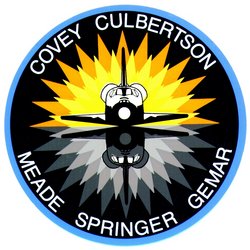STS-38
|
|
| Mission insignia | |
|---|---|
 | |
| Mission statistics | |
| Mission: | STS-38 |
| Shuttle: | Atlantis |
| Launch pad: | 39-A |
| Launch: | November 15, 1990, 6:48:13 p.m. EST |
| Landing: | November 20, 1990, 4:42:42 p.m. EST |
| Duration: | 4 days, 21 hours, 54 minutes, 31 seconds |
| Orbit altitude: | 142 nautical miles (263 km) |
| Orbit inclination: | 28.5 degrees |
| Distance traveled: | 2,030,000 miles (3,267,000 km) |
| Crew photo | |
| Missing image Sts-38_crew.jpg | |
STS-38 was a space shuttle mission by NASA using the Space Shuttle Atlantis. It was the 37th shuttle mission, and carried a payload for the U.S. Department of Defense. Due to this, information about activities performed during the mission is Classified. It was the 7th flight for Atlantis.
| Contents |
Crew
- Commander: Richard O. Covey (flew on STS-51-I, STS-26, STS-38 & STS-61)
- Pilot: Frank L. Culbertson, Jr. (flew on STS-38, STS-51 & ISS Expedition 3)
- Mission Specialist: Robert C. Springer (flew on STS-29 & STS-38)
- Mission Specialist: Carl J. Meade (flew on STS-38, STS-50 & STS-64)
- Mission Specialist: Charles D. Gemar (flew on STS-38, STS-48 & STS-62)
Mission parameters
- Mass:
- Payload: Magnum ELINT satellite ~ 3,000 kg
- Booster: IUS upper stage ~ 18,000 kg
- Perigee: 78 km
- Apogee: 226 km
- Inclination: 28.5°
- Period: 87.5 min
Mission highlights
Department of Defense mission. Payload classified.
According to Aviation Week, STS 38 launched a secret, Magnum ELINT (ELectronic INTtelligence) gathering satellite into geo-synchronous orbit. An identical one was also launched by STS-51-C and STS-33.
It was launched to monitor the events during the first Gulf War in 1990.
Also according to Aviation Week, the shuttle initially enters a 204 km x 519 km orbit at an inclination of 28.45° to the equator. It then executes three OMS (orbital manoeuvering system) burns, the last on orbit #4. The first burn is to circularize the orbit at 519 km.
The satellite was deployed on the 7th orbit and then ignited its IUS rocket at the ascending node of the 8th orbit, to place it in a geo-synchronous transfer orbit.
The classified payload was deployed successfully and boosted into its operating orbit by an Inertial Upper Stage (IUS) booster according to an Air Force announcement.
November 15, 1990, 6:48:13 p.m. EST. Launch originally scheduled for July 1990. However, liquid hydrogen leak found on orbiter Columbia during STS-35 countdown prompted three precautionary tanking tests on Atlantis at pad June 29, July 13 and July 25. Tests confirmed hydrogen fuel leak on external tank side of external tank/orbiter 17 inch (432 mm) quick disconnect umbilical. Could not repair at pad and Atlantis rolled back to VAB August 9, demated and transferred to OPF. During rollback, vehicle parked outside VAB about a day while COLUMBIA/STS-35 stack transferred to pad for launch. Outside, Atlantis suffered minor hail damage to tiles during thunderstorm. After repairs made in OPF, Atlantis transferred to VAB for mating October 2. During hoisting operations, platform beam that should have been removed from aft compartment fell and caused minor damage which was repaired. Vehicle rolled out to Pad A October 12. Fourth mini-tanking test performed October 24, with no excessive hydrogen or oxygen leakage detected. At Flight Readiness Review, launch date set for November 9. Launch reset for November 15 due to payload problems. Liftoff occurred during classified launch window lying within launch period extending from 6:30 to 10:30 p.m. EST, November 15, 1990. Launch Weight: Classified.
November 20, 1990, 4:42:42 p.m. EST, Runway 33, Kennedy Space Center, FL. Rollout distance: 9,032 feet (2753 m). Rollout time: 57 seconds. Mission extended one day due to unacceptable crosswinds at original planned landing site, Edwards. Continued adverse conditions led to decision to shift landing to KSC. First KSC landing for Atlantis, first end-of-mission landing at KSC since April 1985. Landing Weight: 191,091 lb (86.667 Mg).
Related articles
- Space science
- Space shuttle
- List of space shuttle missions
- List of human spaceflights chronologically
External links
- NASA mission summary (http://science.ksc.nasa.gov/shuttle/missions/sts-38/mission-sts-38.html)
| Previous Mission: STS-41 |
Space Shuttle program | Next Mission: STS-35 |
